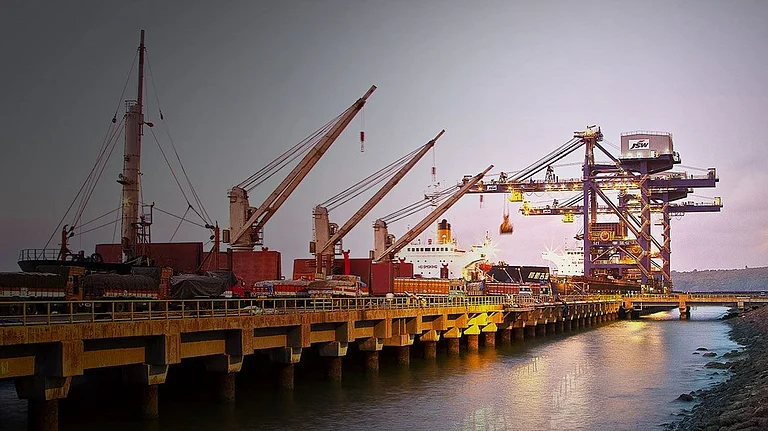India is preparing to revisit the Ganga/Ganges Water-Sharing Treaty with Bangladesh, which is due to expire in 2026. Signed on December 12, 1996, the treaty governs how India and Bangladesh will divide the flow of the Ganges (Ganga) River at the Farakka Barrage from January 1 to May 31 each year. The accord was signed between the former Prime Minister HD Deve Gowda and his Bangladeshi counterpart Sheikh Hasina.
Can India-Bangladesh Navigate a New Ganga Treaty Amid Strain in Ties?
India is set to revisit the Ganges Water-Sharing Treaty with Bangladesh ahead of its 2026 expiry, as shifting geopolitics and rising domestic demand reshape New Delhi’s cross-border water diplomacy
Nearly three decades on, the Indian government is reportedly keen to renegotiate the terms of the treaty to better reflect the country’s current developmental and ecological needs. The New Indian Express reported that New Delhi conveyed that any new agreement must balance water use between West Bengal and Bangladesh while supporting irrigation, port management and hydropower generation in India.
The timing of this development is also notable: it follows India’s move in April 2025 to suspend the Indus Waters Treaty (IWT) of 1960 with Pakistan following the Pahalgam terror attack, which claimed the lives of 26 men, mostly tourists.
What the Ganga Treaty Entails
The treaty mandates India and Bangladesh each to receive 35,000 cubic feet per second of water in alternating 10‑day slots from March 11 to May 10 each year. How much water each side will receive depends on the real-time water availability. Both sides split the water supply 50:50 if the flow is 70,000 cusecs or less. However, Bangladesh’s share is 35,000 cusecs if the flow is between 70,000 and 75,000 cusecs, while India receives the remaining flow. If the flow is 75,000 cusecs or more, India receives 40,000 cusecs, with the excess flow going to Bangladesh.

At Farakka barrage, built in 1975, India diverts water to the Hooghly river to keep Kolkata port navigable. The treaty’s formula–based on historical flow data–was meant to quell disputes from that diversion. Yet, Bangladesh has often accused it of being “biased in India’s favour” and left its farmers short of water in dry years.
Why India May Seek Amendments?
India argues that the 1996 formula of the river treaty does not meet its needs anymore amid the growing water demand of eastern India. Hence, India may seek 30,000 to 35,000 cusecs more during the March to May period. The report also suggests that the Centre has the support of the West Bengal government, which is the primary beneficiary of the additional water. During internal discussions, Bihar too emphasised the need for extra Ganga water to meet its drinking and irrigation needs.
Last year, West Bengal also wrote a letter to the Joint Rivers Commission outlining its industrial and drinking water needs under the Ganga Water Treaty after 2026.
Geopolitical Undercurrents
The proposed review has geopolitical dimensions beyond water-sharing. India’s decision in April to suspend the Indus Waters Treaty, brokered by the World Bank in 1960, signalled a willingness to re-examine even the most long-standing international agreements when national security or strategic interests are perceived to be at stake.
Likewise, India's urging of the Ganges treaty review soon after the Indus affair suggests a broader strategy. New Delhi might be reasserting control over cross-border rivers. On the diplomatic front, while the two countries have historically enjoyed close ties, diplomatic relations have grown more complex in recent months. The relationship between India and Bangladesh is also not at its best. In July last year, long-time Prime Minister Hasina was ousted and an interim administration led by Nobel laureate Muhammad Yunus took charge. It has altered the country's foreign policy noticeably. Whereas Hasina mostly aligned closely with India on several matters, the Yunus-led government appears more open to deepening ties with China and regional players like Pakistan and Turkey.
Speaking at Chatham House earlier this month, Yunus said Bangladesh was “reaching out to everybody” in its diplomatic outreach. During a recent visit to Beijing, he reportedly referred to India’s northeastern states as “landlocked”, a comment that drew sharp criticism in New Delhi.
India, in return, also imposed restrictions on the entry of Bangladeshi ready-made garments (RMG) and other products through its northeastern land ports-Assam, Meghalaya, Tripura, Mizoram-and Fulbari and Changrabandha in West Bengal. The decision forced Dhaka to reroute exports through Kolkata port in West Bengal or Nhava Sheva port in Maharashtra. The move has shot logistics costs up sharply.
Balancing Act
“For any treaty made in good faith, it is the duty of the lower riparian state to respect the upper riparian state to maintain that good faith. How long can we continue to show generosity to support our neighbour when they don’t value our contribution?” an official from the West Bengal government told TNIE.
While India focuses on measures to secure its upstream interests, Bangladesh argues on accessibility and environmental security. The challenge now is to strike a mutually acceptable balance—especially at a time when trust across South Asia appears increasingly fragile.
The path ahead will test both diplomacy and pragmatism. With climate change intensifying water stress and political allegiances shifting, the Ganges treaty could become a litmus test for regional cooperation. How India engages with its historically close neighbour in this next chapter may well define the contours of its broader water diplomacy strategy across the subcontinent.

